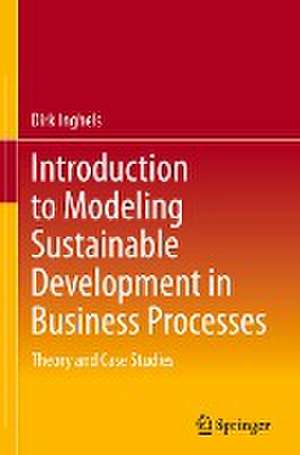Introduction to Modeling Sustainable Development in Business Processes: Theory and Case Studies
Autor Dirk Inghelsen Limba Engleză Hardback – 6 noi 2020
Sustainable development and corporate social responsibility drive countries, regions, and businesses to take environmental and social concerns into account when realizing economic objectives. A growing awareness of the connectedness between industrial, societal, and environmental systems might shift the way businesses will be operated. This book aims to help students and business practitioners use quantitative modeling in their pursuit to make business processes sustainable. Two approaches are introduced: linear optimization and system dynamics. Moreover, the quantification of the three different sustainability objectives is also addressed. Next to introducing the theoretical background, many real-life examples are discussed to demonstrate how the modelling techniques can be applied.
| Toate formatele și edițiile | Preț | Express |
|---|---|---|
| Paperback (1) | 638.11 lei 6-8 săpt. | |
| Springer International Publishing – 7 noi 2021 | 638.11 lei 6-8 săpt. | |
| Hardback (1) | 565.64 lei 38-45 zile | |
| Springer International Publishing – 6 noi 2020 | 565.64 lei 38-45 zile |
Preț: 565.64 lei
Preț vechi: 707.04 lei
-20% Nou
Puncte Express: 848
Preț estimativ în valută:
108.23€ • 113.00$ • 89.58£
108.23€ • 113.00$ • 89.58£
Carte tipărită la comandă
Livrare economică 31 martie-07 aprilie
Preluare comenzi: 021 569.72.76
Specificații
ISBN-13: 9783030584214
ISBN-10: 3030584216
Pagini: 231
Ilustrații: XIII, 231 p. 179 illus., 104 illus. in color.
Dimensiuni: 155 x 235 mm
Greutate: 0.5 kg
Ediția:1st ed. 2020
Editura: Springer International Publishing
Colecția Springer
Locul publicării:Cham, Switzerland
ISBN-10: 3030584216
Pagini: 231
Ilustrații: XIII, 231 p. 179 illus., 104 illus. in color.
Dimensiuni: 155 x 235 mm
Greutate: 0.5 kg
Ediția:1st ed. 2020
Editura: Springer International Publishing
Colecția Springer
Locul publicării:Cham, Switzerland
Cuprins
Chapter 1: General Introduction.- Chapter 2: Single Objective Optimization.- Chapter 3: Multiple Objective Optimization.- Chapter 4: Quantifying The Economic Impact.- Chapter 5: Quantification Of The Environmental Impact.- Chapter 6: Quantifying The Social Impact.- Chapter 7: Systems Thinking And Introduction To System Dynamics Modeling.- Chapter 8: Causal Loop Diagrams.- Chapter 9: Structure And Fundamental Modes Of Behavior Of Dynamic Systems.- Chapter 10: Stocks And Flows And The Dynamics Of Simple Structures.- Chapter 11: Delays.- Chapter 12: Nonlinear Behavior.
Notă biografică
Dr. Ir. Dirk Inghels is an Assistant Professor in the Supply Chain Analytics department of the School of Business and Economics at the Vrije Universiteit Amsterdam. He obtained his Ph.D. with a thesis entitled “Policy Modelling for Sustainable Waste Management” in 2016. He holds an M.Sc. (2006) in Industrial Engineering and Management Science from Eindhoven University, an M.Sc. (2000) in Industrial Management from Ghent University, and an M.Sc. (1990) in Industrial Sciences from the University of Antwerp.
Dirk Inghels has more than 10 years of experience in the domain of sustainable supply chain management, and his research focuses on sustainable supply chain management in the public and private sectors. His ongoing research concentrates on integrating operations research techniques in topics related to sustainable supply chain management and on improvements in quality management.
In addition to his academic work, Dirk Inghels hasmore than 30 years of industry experience in different domains such as engineering, quality, and sustainability. He is currently the Quality, Health, Safety, and Environmental Senior Manager at Aleris Aluminum BV in Duffel, Belgium. He is also responsible for sustainability in this position.
Dirk Inghels has more than 10 years of experience in the domain of sustainable supply chain management, and his research focuses on sustainable supply chain management in the public and private sectors. His ongoing research concentrates on integrating operations research techniques in topics related to sustainable supply chain management and on improvements in quality management.
In addition to his academic work, Dirk Inghels hasmore than 30 years of industry experience in different domains such as engineering, quality, and sustainability. He is currently the Quality, Health, Safety, and Environmental Senior Manager at Aleris Aluminum BV in Duffel, Belgium. He is also responsible for sustainability in this position.
Textul de pe ultima copertă
Sustainable development and corporate social responsibility drive countries, regions, and businesses to take environmental and social concerns into account when realizing economic objectives. A growing awareness of the connectedness between industrial, societal, and environmental systems might shift the way businesses will be operated. This book aims to help students and business practitioners use quantitative modeling in their pursuit to make business processes sustainable. Two approaches are introduced: linear optimization and system dynamics. Moreover, the quantification of the three different sustainability objectives is also addressed. Next to introducing the theoretical background, many real-life examples are discussed to demonstrate how the modelling techniques can be applied.
Caracteristici
Offers a framework on how to include environmental and societal issues in supply chain management Presents triple bottom line optimization (people-planet-profit) for supply chain problems Illustrated examples to help the reader practice concepts and modeling techniques
